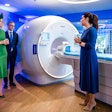PHILADELPHIA - Driven by new certification requirements for specialists from the Royal College of Physicians and Surgeons of Canada (RCPSC), the Alberta Society of Radiologists launched a pilot program last year to develop Web-based educational modules for radiologists. After a successful launch, the program is preparing to face its next major challenge: becoming self-supporting.
In a presentation June 5 at the Symposium for Computer Applications in Radiology (SCAR), Dr. Bernice M. Capusten, a radiologist with the Red Deer Regional Hospital in Alberta, Canada, said she got her first inspiration for developing Web-based educational modules during the Enterprise sessions held at Chicago's RSNA meeting in 1997. The insight proved useful about six months later, when RCPSC adopted its new Maintenance of Certification program for specialists, she said. (The program is comparable to the Category I program in the U.S.)
Web-based materials offer several advantages over on-site education for doctors, she said, including their complete independence of time and place. This allows busy doctors to log on and complete the instructional course at their convenience, wherever there's a computer with an Internet connection, she said. In addition, Web-based programs are also learner- rather than teacher-oriented, offering the freedom to choose the most relevant materials. These qualities are especially valuable in Canada's wide-open spaces, where a few radiologists must serve a large, widely dispersed patient population.
"In the province of Alberta, which is about the size of California, there are about three million people and 174 radiologists. In the whole country of Canada, which has a population of about 30 million people, there are about 3,000 radiologists," she said.
One hundred and one of the province's 174 radiologists showed interest in the program, and about 50 have completed modules so far. Participants were e-mailed in advance that a new module was available, and then given a month to complete and submit it, which required about an hour to complete 50 image-based questions. Questions were built into each module asking for comments about the appropriateness of the questions, and the length of the test, etc.
The modules are based on active server pages, and use a relational database to link the participants with the questions and answers, she said.
She cited several challenges to building an effective program, including time, money, expertise, and marketing challenges.
"As much as the software component is important and should be user-friendly, the content has got to be there as well," she said. "Radiologists don't have time to spend learning information that they can't actually apply to their own work."
Capusten, who chairs the committee on continued professional development for the Canadian Association of Radiologists (CAR), said the modules were designed to incorporate standards from many professional sources, including standards of practice from CAR, the American College of Radiology, and new policies from the College of Physicians and Surgeons of Alberta, and others.
"I have been reluctant to take money from large commercial companies. I don't want the material to be seen to be influenced in any way," she said.
The software is continually updated to make it easier to use, she said. This year the program has added Java capabilities, and has been modified to run on both the Netscape and Microsoft Internet Explorer browsers. Soon users will be able to stop the sessions in order to complete them at a later time, and improvements in image quality are also in the works. The latest module is available at www.medimage.org, Capusten said.
Next year the program faces its first major hurdle, when users will be asked to begin paying for the courses. While the program must be self-supporting in order to be worthwhile, Capusten said, she is confident that Web-based education for radiologists will continue to grow in importance.
"The bottom line is, we earn what we learn," she said, "and education is very important if we want to retain our role as leaders in medical imaging."
By Eric Barnes
AuntMinnie.com staff writer
June 6, 2000
Let AuntMinnie.com know what you think about this story.
Copyright © 2000 AuntMinnie.com



















